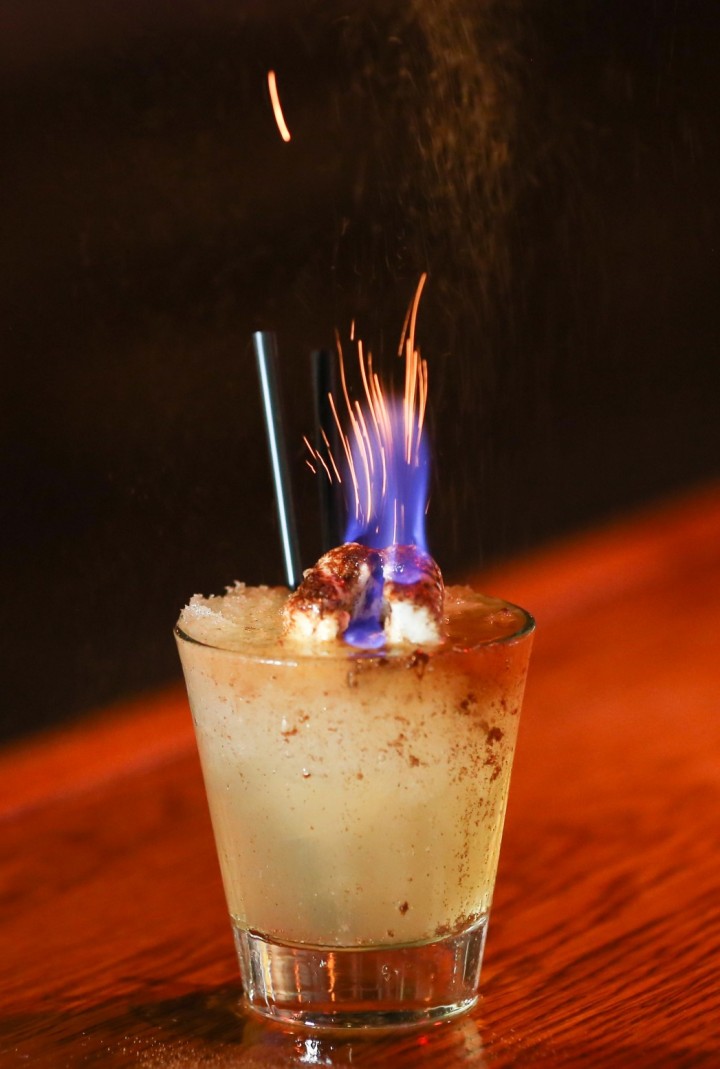
For bartenders who enjoy theatrics, there’s nothing quite like adding flames to a cocktail. Besides creating an impressive show, fire also enhances many drinks by providing smokiness and heat, caramelizing sugars and lowering the alcohol content of certain high-proof spirits. The practice has long been used in tiki culture and is now gaining momentum at more mainstream bars.
“Fire gives a sense of danger and allure,” says Rob Ficks, lead bartender at Craigie on Main in Cambridge, Massachusetts. “In the midst of creating serious cocktails, sometimes it’s necessary to take a step back and show our guests that we have fun with what we do, and fire is certainly a way to do that.” Craigie On Main offers drinks like the Queens Park Swizzle ($11), comprising Cruzan Black Strap rum, simple syrup, lime juice and mint, served over crushed ice and topped with a Lemon Hart 151 Demerara rum–filled lime rind that’s set aflame. “It adds the dimension of dueling temperatures because you have flaming hot rum sitting on top of a summer cooler–style drink served over crushed ice,” Ficks explains.
Jon Eiswerth, the bar manager at Acabar in Los Angeles, also fills a lime husk with Lemon Hart 151 and sets it afire to top his take on the Zombie cocktail ($14). The drink comprises El Dorado 8-year-old rum, John D. Taylor Velvet Falernum liqueur, Angostura bitters, grenadine, lime and grapefruit. “Adding a hint of danger and sexiness to a cocktail provides oohs and aahs,” Eiswerth notes. “Fire also adds to a drink’s taste and aroma by changing the chemical breakdown of its ingredients and providing hints of singed or burnt flavors.”
At Mott Street in Chicago, bartender Davis Cox mixes the Flaming Tiki Baby ($8), comprising Banks 5 Island White rum and Ron Botran Reserva rum with Meyer lemon shrub, lemon juice and Demerara sugar, topped with a fiery lime bowl filled with Lemon Hart 151 rum. “A live flame on a cocktail can add a beautiful layer of aromatics,” Cox says, adding that a flaming citrus element provides sweetness. “It caramelizes the sugars and tones down some of the oils, making it more appropriate for drinks that could use an extra citrus push, but not a ton of power.”
Fire is a regular part of the experience at Tiki No in North Hollywood, California. Manager Tara Ivy Salinas enjoys the flair involved in using fire, emphasizing the wow factor it provides her guests. She says Cruzan 151 rum is her bar’s fuel of choice and notes that adding cinnamon to the mix creates a sparkler effect. Tiki No has drinks like the Toasted Marshmallow ($10), comprising J. Wray & Nephew White Overproof rum, Smirnoff Fluffed Marshmallow vodka, Licor 43 liqueur, Fee Brothers Falernum cordial, apple juice and fresh lemon, topped with a marshmallow marinated in Cruzan 151, sprinkled with cinnamon and lit on fire. “Burning off some of the liquid allows the nuances of the spirits to be recognized,” Salinas says. “People are fascinated with fire, and using it to create an excellent cocktail is fun.”
Along with whiskies and over-proof rums, absinthe also lends itself to fire. At Faith & Flower in Los Angeles, bar manager Michael Lay serves the Leap of Faith ($25), which is both showy and sophisticated. The bartender fills a snifter with several ounces of Pernod absinthe and lights the liquid on fire. Then the flaming absinthe—which burns bright blue—is poured into a rocks glass that’s filled with root beer and ice. “It’s all about the show,” Lay says.
Bartenders also experiment with using fire on garnishes. Nicolas Torres, bar director at Lazy Bear in San Francisco, flames a grapefruit peel over his Burnt Monk ($12), mixed with Green Chartreuse liqueur, Valdespino Inocente Single Vineyard Fino Sherry, Angostura bitters, grapefruit shrub and lime juice. Meanwhile, Jason Kaciupski, head mixologist at Queen of the Night in New York City, chars sage sprigs in A Willing Gentleman ($16), comprising Maker’s Mark Bourbon, sage and ginger simple syrup, and lime and orange juices. Dane Tuzzo, the sommelier at BLT Steak New York, burns clove bulbs in The Smoking Gun ($15), blending Woodford Reserve Bourbon, Martini & Rossi Sweet vermouth and Cointreau orange liqueur.
“Fire offers complexity to the flavor of a drink and makes for exciting entertainment,” Tuzzo says. “A Manhattan with a flamed fruit peel is very different from a Manhattan without one. This type of showmanship offers a way to stand out from the pack and generates excitement at the bar.”